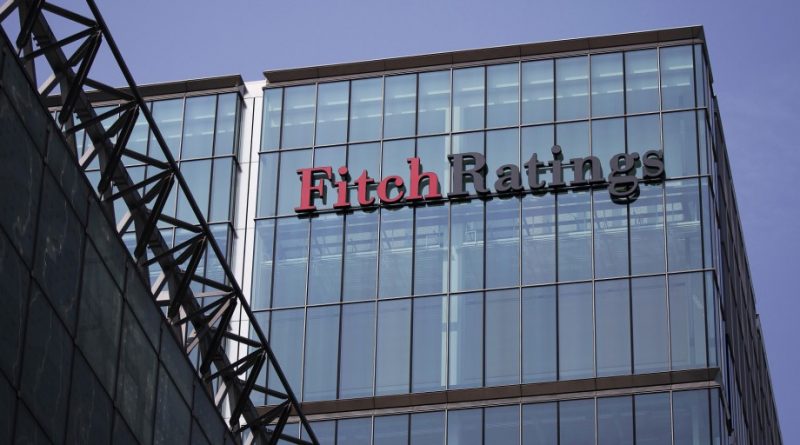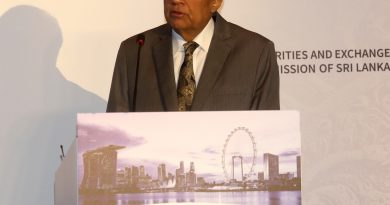Fitch maintains ‘B+’ rating on Sri Lanka; outlook ‘Stable’
Fitch Ratings has maintained Sri Lanka’s ‘B+’ rating with a ‘Stable’ outlook.
Fitch downgraded Sri Lanka by one notch from ‘BB-’ to ‘B+’ with a ‘Negative’ outlook in February 2016 on higher external debt.
However, in July 2017, the rating agency revised the outlook to ‘Stable’.
In a review to justify its latest rating stance, Fitch yesterday said Sri Lanka’s revised policy framework supports macroeconomic stability.
In Fitch’s view, policies aimed at fiscal consolidation and maintenance of a disciplined monetary stance under the framework of the three-year International Monetary Fund (IMF)-supported programme have improved Sri Lanka’s policy coherence and credibility.
Although the gross domestic product (GDP) growth of an estimated 3.9 percent in 2017 fell short of forecasts due to weather-related supply disruptions, Fitch expects growth to recover and stabilise at around 5 percent in 2018 and 2019.
The rating agency also said the shift towards greater exchange-rate flexibility since 2H15 has strengthened the external position and the planned shift towards flexible inflation targeting should further enhance monetary policy credibility.
Fitch also acknowledged the relatively lower credit growth of around 15 percent in 2017 compared to the high of 20 percent in 2016.
Meanwhile, the rating agency said, Sri Lanka’s fiscal performance has improved following the approval and implementation of tax reforms.
Fitch expects Sri Lanka’s ratio of general government revenue to GDP to improve to 15.5 percent in 2018 and 16.2 percent by 2019, from a low of 11.6 percent in 2014, reflecting the passage of revenue enhancing measures under the IMF programme.
These include an increase in the value-added tax rate to 15 percent in 2016 from 11 percent and implementation of a new Inland Revenue Act from April 1, 2018 that aims to simplify tax laws, reduce exemptions and improve the efficiency of the tax system. “We think the increase in general government revenues will support a further narrowing of the budget deficit to 4.8 percent of GDP in 2018 and 4 percent in 2019 from an estimated 5.2 percent in 2017.
While these revenue reforms should be positive for a more credible fiscal framework over time, ineffective implementation and/or weaker-than-expected GDP growth remain downside risks to our fiscal projections,” Fitch said.
Meanwhile, commenting on the country’s debt dynamics, Fitch noted that Sri Lanka’s interest payments as a share of revenues remain exceptionally high at an estimated 38 percent at end-2017, far above the medians of 9.4 percent for ‘B’ and 9.6 percent for ‘BB’-rated sovereigns.
“The expected pick-up in general government revenues should lead to lower ratios over time but we expect this ratio to remain above the ‘B’ and ‘BB’ medians for the foreseeable future. Further, despite the expected improvement in gross general government debt (GGGD) dynamics, GGGD will likely remain above the ‘B’ median over 2018-2019,” Fitch said.
“GGGD is forecast to decline to 77.2 percent of GDP in 2018 and 75.8 percent in 2019, from an estimated 79.5 percent at end-2017 under our baseline assumptions, mainly on account of sustained primary surpluses and stable GDP growth rates,” the rating agency added.
However, Fitch noted that even after the forecast reduction, government debt would still remain above the ‘B’ and ‘BB’ medians at end-2019. Further, nearly half of Sri Lanka’s government debt is denominated in foreign currency, which increases the risk to debt dynamics in the event of a further depreciation of the Sri Lankan rupee. Fitch also said Sri Lanka’s external balance sheet remains a weakness for the rating, with high net external debt, weak sovereign net foreign assets and a low international liquidity ratio compared with rating peers. Sri Lanka’s foreign-exchange reserves rose to around US $ 8 billion at end-2017, representing 3.3 months of current external payments (CXP), from US $ 6.0 billion (2.7 months) at end-2016, but reserves remain below the rating category median of 3.9 months. Fitch said the improvement in reserves reflects the allowance of greater exchange-rate flexibility, as well as a combination of FX purchases from the market, inflows from the Hambantota port lease and new external borrowings. On the country’s debt servicing, Fitch said Sri Lanka’s external debt service outlook remains challenging over 2019-2022 as the sovereign’s external debt service payments over this period are around US $ 15 billion, against the current reserve levels of about US $ 7.7 billion.
The authorities expect to pass a liability management bill in 2018, which would allow them to smooth debt payments by potentially extending maturities over this period. However, the scale of external refinancing over the next few years creates a potential vulnerability for the sovereign, particularly against a backdrop of expected monetary tightening in developed markets.
However, Fitch noted that Sri Lanka’s track record of accessing international capital markets remains a mitigating factor. Meanwhile, Fitch’s maintained its negative outlook on Sri Lanka’s banking sector on their assessment of a difficult operating environment. The rating agency said this is reflected in an increase in non-performing loans following a period of rapid credit growth and some capitalisation pressures.
Mentioning the factors that support Sri Lanka’s current rating, Fitch said structural factors, such as governance standards, GDP per capita and levels of human development are high compared with the ‘B’ and ‘BB’ medians and continue to provide support to the rating. In the United Nation’s Human Development Index, Sri Lanka ranks in the 61st percentile compared with the ‘B’ median of the 36th percentile.
On the World Bank’s composite governance indicator score, Sri Lanka ranks at a favourable 48th percentile against the ‘B’ median of the 31st percentile.




